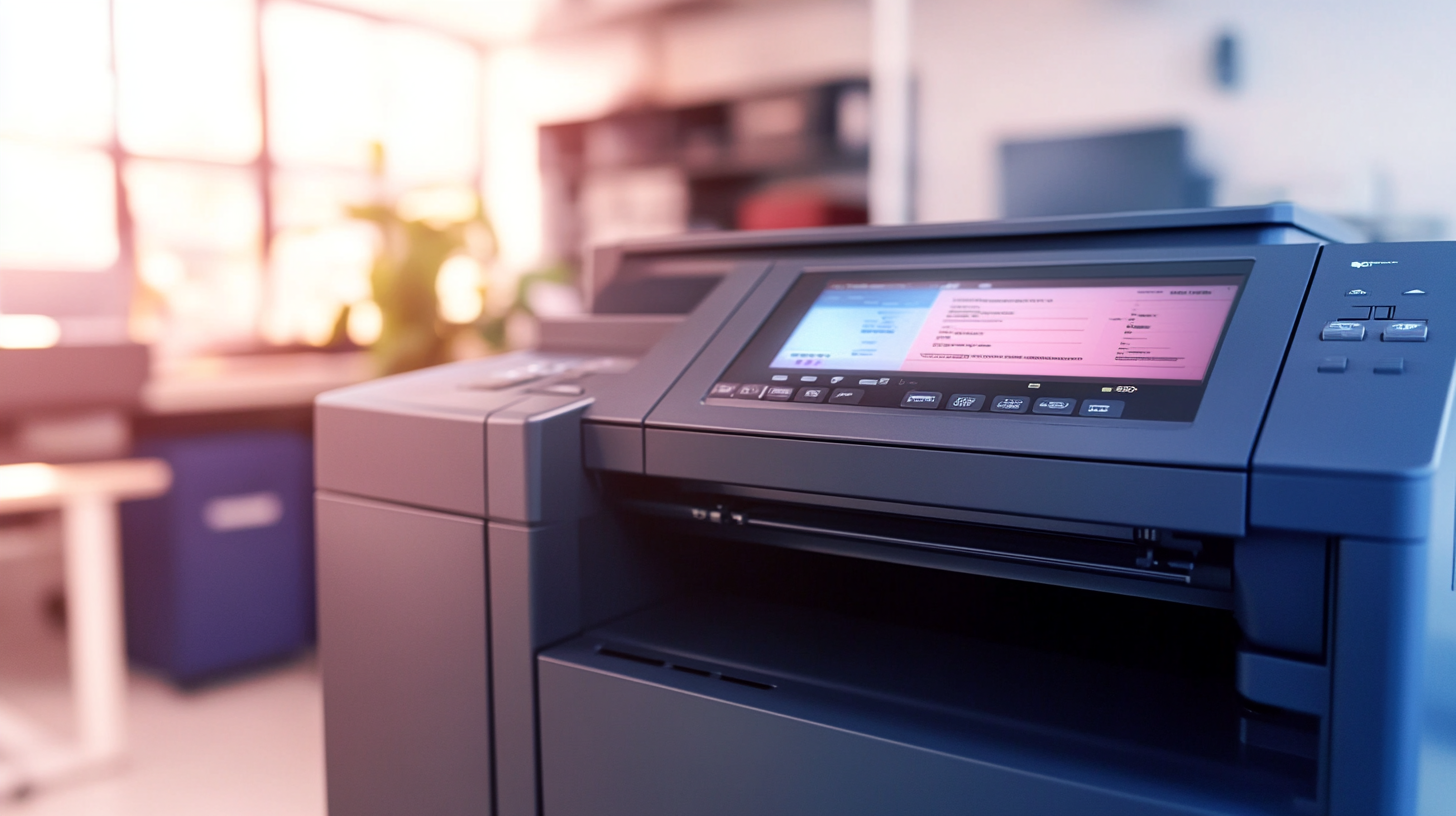Partner Login
Enter your username and password here on order to log in on the partner portal:
No registered partner yet?
Register nowNavigating Global Trade with Best Cij Printers Compliance and Certification Standards
In today's rapidly evolving global market, the role of compliance and certification standards in the operation of Continuous Inkjet (Cij) printers has become increasingly prominent. According to recent reports by industry leaders such as Smithers Pira, the global coding and marking market, dominated by technologies like Cij printing, is projected to reach $4.7 billion by 2026, driven by stringent regulatory requirements and the need for traceability in supply chains. Ensuring that Cij printers meet these compliance standards not only enhances operational workflows but also mitigates the risks associated with cross-border trade. This blog will delve into the essential "how-to" strategies for navigating the complexities of global trade while adhering to best practices in Cij printer compliance and certification, empowering businesses to make informed decisions that align with industry regulations and standards.

Understanding Compliance Standards for Cij Printers in Global Trade
Understanding compliance standards for Continuous Inkjet (CIJ) printers is essential in today's global trade landscape. As companies strive to meet regulatory requirements, the significance of adhering to established certification standards becomes increasingly apparent. These standards not only enhance product quality but also facilitate smoother international transactions. With consumers demanding clearer product information and better traceability, the role of CIJ printers in providing precise coding and marking cannot be overstated.
Recent innovations in packaging, such as the adoption of advanced coding systems, are helping to ensure food safety and enhance transparency. For instance, new technologies that utilize 2D codes are becoming crucial for compliance with rising standards in traceability, as seen with impending regulations set to take effect in January 2027.
By integrating these innovations, businesses can improve their supply chain efficiency while simultaneously building consumer trust through reliable and verifiable product information. With the global market evolving rapidly, staying ahead of compliance standards is not just a regulatory obligation; it's a strategic advantage.
Key Certification Requirements for Cij Printers Across Different Markets
When it comes to CIJ (Continuous Inkjet) printers, understanding certification requirements is crucial for businesses looking to succeed in diverse global markets. Each region has its own set of compliance standards, which can significantly impact a company's ability to introduce new printing solutions. For instance, in the European Union, CIJ printers must adhere to CE marking requirements, ensuring that they meet health, safety, and environmental protection standards. Meanwhile, in the United States, compliance with OSHA regulations and ANSI standards is non-negotiable for manufacturers aiming to sell their products domestically.
Beyond regional regulations, industry-specific certifications also play a vital role in market acceptance. In sectors such as food and beverage, CIJ printers often require FDA compliance to ensure that the inks and materials used are safe for contact with consumables. Similarly, in pharmaceuticals, adherence to cGMP (current Good Manufacturing Practices) is essential for maintaining quality control and traceability. By navigating these various certification requirements efficiently, businesses can not only streamline their entry into new markets but also build trust with customers who prioritize safety and reliability in their printing solutions.

The Role of Quality Assurance in Cij Printer Compliance
In the ever-evolving landscape of global trade, compliance and certification standards for CIJ (Continuous Inkjet) printers play a vital role in ensuring product quality and market accessibility. Quality assurance emerges as a key factor in maintaining these standards, offering a framework for manufacturers to meet the rigorous demands of international markets. By implementing robust quality control measures, companies can guarantee that their CIJ printers comply with necessary regulations, ultimately enhancing their credibility and competitiveness in the global marketplace.
Recent industry developments signify the importance of these standards, as evidenced by collaborative efforts among leading manufacturers celebrating milestones, such as their anniversary of partnership. Such events highlight not only advancements in technology but also the critical role quality assurance plays in the coding and marking sector. As businesses navigate complex compliance landscapes, a commitment to maintaining high-quality standards will be essential for sustained success and innovation in CIJ printing, ensuring that products are marked accurately and meet consumer expectations worldwide.
Navigating Regulatory Challenges in International Trade for Cij Printers
Navigating the intricate landscape of international trade presents unique challenges, particularly for industries relying on Continuous Inkjet (CIJ) printers. Compliance with regulatory requirements is paramount to avoid costly delays and maintain market access. Different countries have varying certification standards, which can make it daunting for manufacturers and exporters to ensure their CIJ printers meet all necessary criteria. Understanding these regulations is essential for businesses aiming to thrive in a global marketplace.
To successfully navigate these regulatory challenges, companies must invest time in research and establish a strong framework for compliance. This includes staying updated on local laws, environmental regulations, and safety standards that vary by region. Collaborating with compliance experts or engaging with industry associations can also provide valuable insights and resources. By prioritizing adherence to these standards, businesses can not only avoid penalties but also enhance their reputation and build trust with international clients, ultimately leading to increased opportunities for growth in the competitive landscape of global trade.
Navigating Global Trade: Compliance and Certification Standards for CIJ Printers
This chart illustrates the compliance rates for Continuous Inkjet (CIJ) printers across various global regulatory standards. It highlights the necessity for manufacturers to adhere to these standards to navigate international trade effectively.
Best Practices for Ensuring Sustainable Compliance in Cij Printing Operations
 Ensuring sustainable compliance in Continuous Inkjet (CIJ) printing operations is critical for businesses aiming to navigate the complexities of global trade. One of the primary best practices is to maintain meticulous documentation of the materials and chemicals used throughout the printing process. By keeping an accurate inventory and labeling of inks and solvents, companies can not only comply with local and international regulations but also demonstrate commitment to environmental stewardship. This approach minimizes the risk of contamination and non-compliance, helping businesses build trust with stakeholders and clients.
Ensuring sustainable compliance in Continuous Inkjet (CIJ) printing operations is critical for businesses aiming to navigate the complexities of global trade. One of the primary best practices is to maintain meticulous documentation of the materials and chemicals used throughout the printing process. By keeping an accurate inventory and labeling of inks and solvents, companies can not only comply with local and international regulations but also demonstrate commitment to environmental stewardship. This approach minimizes the risk of contamination and non-compliance, helping businesses build trust with stakeholders and clients.
Additionally, regular training sessions for employees about compliance standards and safety protocols are essential. Empowering staff with knowledge about the latest regulations and sustainable practices fosters a culture of responsibility and awareness within the organization. Implementing a robust auditing system to periodically assess compliance with established standards can also help identify areas for improvement and ensure adherence to both corporate and legal requirements.
Through these practices, CIJ printing operations can effectively balance efficiency with sustainability, reinforcing their position in the competitive landscape of global trade.